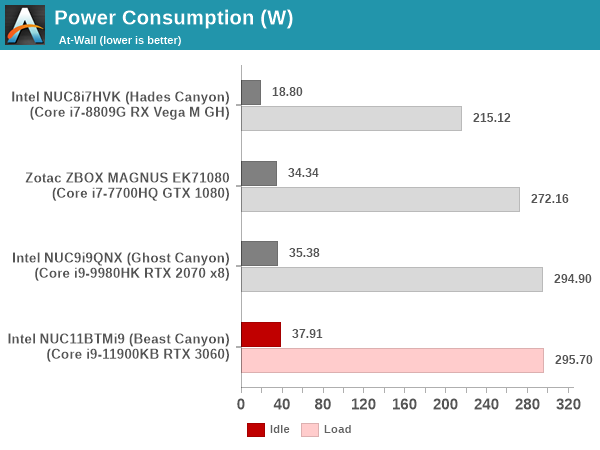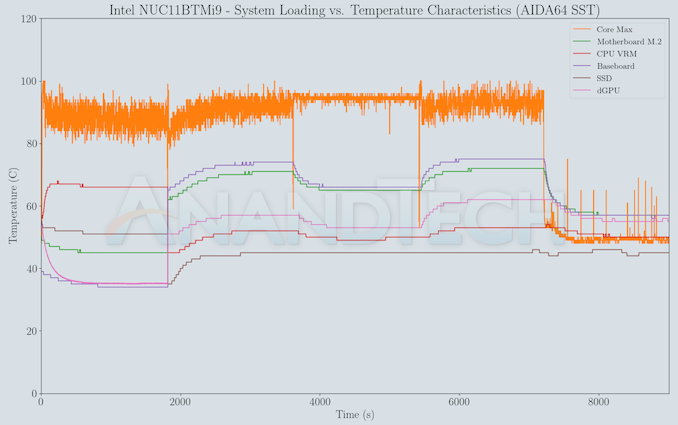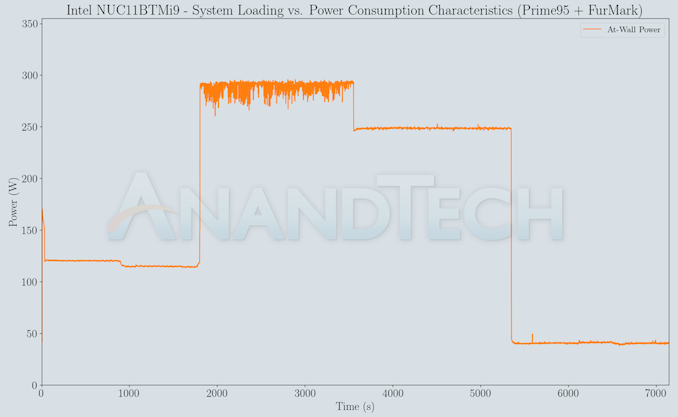Intel Beast Canyon NUC Review: Desktop Tiger Lake Debuts in SFF Gaming Powerhouse
by Ganesh T S on July 29, 2021 9:00 AM EST- Posted in
- Systems
- Intel
- NUC
- Tiger Lake
- NUC11
- Beast Canyon
Power Consumption and Thermal Performance
The power consumption at the wall was measured with a 4K display being driven through the HDMI port of the discrete GPU. In the graphs below, we compare the idle and load power of the Intel NUC11BTMi9 (Beast Canyon) with other similar PCs evaluated before. For load power consumption, we ran the AIDA64 System Stability Test with various stress components, as well as the artificial power virus test involving Prime95 and Furmark. The maximum sustained power consumption at the wall was recorded.

The numbers are very similar to the ones obtained for the Ghost Canyon NUC.
Our thermal stress routine starts with the system at idle, followed by four stages of different system loading profiles using the AIDA64 System Stability Test (each of 30 minutes duration). In the first stage, we stress the CPU, caches and RAM. In the second stage, we add the GPU to the above list. In the third stage, we stress the GPU standalone. In the final stage, we stress all the system components (including the disks). Beyond this, we leave the unit idle in order to determine how quickly the various temperatures in the system can come back to normal idling range. The various temperatures and power consumption number for the system during the above routine are presented in the graphs below.
While the CPU package manages to stay below the junction temperature during the system stability test, it does hover very close to the limits. This is likely due to the fans not taking effect soon enough, as the BIOS tries to maintain a balance between noise levels and cooling efficiency. It is likely that the production BIOS will need to sacrifice some noise levels for better thermals. Despite significant loading on the SSD, the thermal solution is good enough to keep the temperature below 75C.
A similar test routine is conducted with Prime95 running in maximum power consumption mode for 30 minutes, followed by the addition of a FurMark stress workload for another 30 minutes. After a cumulative run time of a hour, the Prime95 workload is removed, and FurMark allowed to proceed for another 30 minutes. The system is then left idle for another half an hour. The metrics tracked in the AIDA64 SST case are also tracked here.
The artificial power virus test significantly amps up the power consumption when both Prime95 and Furmark are simultaneously active. The GPU temperature is also a bit toasty and seems to suffer some after-effects of the Furmark loading. However, the core temperature quickly falls down to around 50C, thanks to the well-ventilated chassis and the three fans on the top panel.














84 Comments
View All Comments
vegemeister - Friday, July 30, 2021 - link
Actual gaming consoles are stateless or nearly so, and get rebooted fresh every time they're used.PCs that are used for gaming do not work like that.
Spunjji - Friday, July 30, 2021 - link
I have literally never had a computer that wasn't overclocked fail due to a random bit-flip memory error, but okay, I guess they were all toys and we should all be paying extra for redundant chips on our DIMMs 🤷♂️willis936 - Friday, July 30, 2021 - link
What a valuable anecdote.mode_13h - Monday, August 2, 2021 - link
In PC help forums, it's not uncommon to find users complaining of system instability, only for it to turn out they have bad RAM. ECC buys you some initial protection + notification (if you know where to look) that your RAM is failing.Unashamed_unoriginal_username_x86 - Friday, July 30, 2021 - link
there is a scale of snobbery from gamer to anti-gamer and it is a horseshoeAlso ECC is still vulnerable to remote rowhammer attacks
Oxford Guy - Wednesday, August 11, 2021 - link
Yes... if you want more security you don’t want ECC. Security via data corruption!mode_13h - Thursday, August 12, 2021 - link
> remote rowhammer attacksThat's a new one! How does it even work? A rowhammer attack hits a DRAM row so frequently that an adjacent row changes. It's an *extremely* targeted attack, and requires the attacker to have some detailed knowledge of the target process' memory layout for it to have much potential as an exploit.
Furthermore, if it works, you're just going to cause random bit-flips. To beat ECC, you actually need to cause at least 3 bit flips, or I guess only 2 if your goal is to make the process abort.
Finally, to actually fetch a row of DRAM means it can't be in the cache hierarchy. So, you've got to explicitly invalidate the cacheline or do something else to ensure it's evicted.
So, the first question is how can one *remotely* hammer a row of DRAM? Wouldn't any sort of protection against DoS attacks occur, long before you could do it? And how are you going to ensure it keeps getting evicted from the cache hierarchy?
In actual practice, the only real risk I see of Rowhammer is when one VM tenant just wants to create lots of chaos in the other tenants. It's not a complete non-issue, but also probably ranks fairly low on the scale of exploits.
And it's *certainly* not an argument against using ECC. If anything, it's yet another reason *to* use it, since ECC can correct minor instances and detect many others. Without ECC, you'd be even *more* vulnerable, and you'd be much less likely to have any clue that it's happening.
ads295 - Thursday, July 29, 2021 - link
One usually moves towards desktop PCs in order to move away from expensive-to-replace custom hardware found in laptops, amongst other things. I would not buy this if it was going to cost a bomb to replace in case of some motherboard related issue.meacupla - Thursday, July 29, 2021 - link
Other than the CPU and compute unit pcb itself, I don't see anything on the compute unit that isn't easily replaceable.PSU, GPU, RAM and SSD are all replaceable, which is really about as good as it gets for something that is using laptop parts.
Going to a desktop, the only additional thing you can replace is the CPU.
Spunjji - Friday, July 30, 2021 - link
"Other than the CPU and compute unit pcb itself"That's a pretty big "other than!" - if an ITX motherboard fails, you can replace that without buying a new CPU. Same goes for an upgrade / replacement of the CPU itself. Those are at least ~$150+ and ~$350+ expenses, respectively, for something of this calibre.